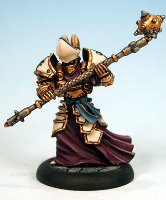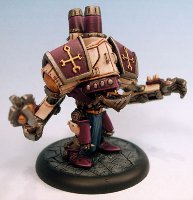Warmachine: The Vermillion Menofix
It’s time to switch gears a little bit and discuss my wargaming and painting hobbies to fill out the blarging categories I had planned to start with.
Roughly a year ago a friend and I picked up Warmachine, a miniature wargame by Privateer Press. Since then we’ve played roughly weekly and have added a couple of players to our little group (though one has gone MIA after becoming a father). Since I’ll likely talk about the game and the miniatures in the future I’m going to take this opportunity to talk about why Warmachine is my game of choice, why I play the faction I do, and finally how I came up with the color scheme I chose for my army.
I enjoy the warcaster-centric style of play that Warmachine features. Especially since while being the most powerful model in your army, the warcaster is still far from invulnerable and in most cases requires protection to keep him safe. And with good reason – in many cases killing your warcaster is how your opponent wins the game. To use a chess analogy, your warcaster is a combination of the king and the queen. This dichotomy forces you to balance using the piece as an offensive weapon with keeping it safe from your opponents.
Unlike many other games, in Warmachine you can’t customize an individual unit or model and some people may consider that a con. While it’s true you can’t swap out weapons or magic items on a warcaster, you also don’t have to purchase, assemble, convert, and paint a second version of the warcaster just because you want to swap a pistol out for a spear. You also know exactly what to expect from your opponents’ models when they set them on the table – no combing over army lists and through artifact appendices to determine your opponent’s exact capabilities.
One thing that should be pointed out is that this doesn’t prevent a painter from converting his miniatures. While there are no limits on conversions for friendly games, if a player wants to use a miniature in a Privateer Press sanctioned event he has to follow their conversion guidelines. These guidelines generally come down to making sure the miniature properly represents the model in question and otherwise allowing for the tournament organizer’s discretion to be the final ruling. Most organizers are relatively liberal, but an important restriction is that the model has to retain the proper weapons. So while a plain shortsword could be replaced with a more elaborate broadsword, the same sword couldn’t be replaced with an axe.
I learned long ago that when I play games I tend to favor the strategy that let me tell my opponents “No.” Even when I used to play a few CCGs I always seemed to fill out my decks with cancellation or prevention cards in an attempt to disrupt my opponents’ strategies. And in Warmachine there’s no faction that can say “No” better than the Protectorate of Menoth.
“None of these warjacks can be shot at this turn.”
“Those models that you killed… I’m returning them to play.”
“This unit over here is immune to damage for a turn.”
“You killed my one knight, so his buddies all gain an armor and strength bonus for the rest of the game. And since you angered the Seneschal, he’s getting a similar bonus for one turn.”
“All those spells you cast last turn to protect your army and set up to slaughter my troops next turn? I’m dispelling them.”
These are the reasons my regular opponents despise the Protectorate, which is in turn why I enjoy the faction so much.
I originally picked the Protectorate for play style, but once I did it was very easy to get into the fluff and back story of the faction. A strictly religious state that had broken off from the default “good guy” country in the Iron Kingdoms, the Protectorate of Menoth was led by a Hierarch who is driving the nation into a religious frenzy. Although poorly armed and armored when compared to the other nations of Western Immoren, they have a zealous dedication to the cause unmatched in other nations. They’ll stop at to burn the heretics from the face of Immoren. Mine is a Righteous Fury!
When I was choosing a color scheme for my army, I wanted to remain close to the traditional Protectorate colors (white with red accenting) but at the same time have something unique. I quickly decided that despite the fact that the Protectorate is one of the relative evils of the Iron Kingdoms, I didn’t want them painted in a manner that screamed “villain.” One of the interesting aspects of the setting is that most of the antagonistic factions all feel they’re the good guys of the land. The Menites feel their crusade is a holy one, validated by their god’s will. They feel their cause is good and just.
I wanted to preserve this feel of self-validation, so didn’t want to use a color or color combination that immediately implied “evil” to the viewer. So I chose to go the other direction with colors that looked regal and sacred. After looking through my paint collection and the various miniatures I had painted, I found myself really liking the look of the Royal Plum color I had used on one’s tabard. This purplish color had a deep royal feel and the reddish tint made it ever so reminiscent of the typical Menite red.
 My Royal Plum was paired up with a tannish off-white color for a number of reasons. Besides the similarity to the white used on Privateer Press’s studio Protectorate figures, I realized that I could vary the color depending on the caste of the model represented. For miniatures representing higher ranking individuals – such as Knights Exemplar and Warcasters – the tan could be brighter up to almost pure white while lower caste models – such as Holy Zealots and Deliverers – would be a mix with more tan, giving them a dirtier look.
My Royal Plum was paired up with a tannish off-white color for a number of reasons. Besides the similarity to the white used on Privateer Press’s studio Protectorate figures, I realized that I could vary the color depending on the caste of the model represented. For miniatures representing higher ranking individuals – such as Knights Exemplar and Warcasters – the tan could be brighter up to almost pure white while lower caste models – such as Holy Zealots and Deliverers – would be a mix with more tan, giving them a dirtier look.
The obvious choice for metallics for my regal color scheme was gold, but after looking at some of the miniatures I had to paint I realized that too much gold would look to gaudy. I decided to save it for some of the more important or accent locations and use traditional silver for the rest.
 Finally I needed an additional accent color; something other than brown or black (which would see use on straps and leather) that could be used to on smaller areas of some models to accent the purple and make the miniature “pop.” After talking over my colors with my fiancée, she felt a bluish gray would work wonderfully. I was doubtful at first, but after she mixed up a sample of the color and we placed it next to paint chips for the purple and tan I was surprised how well it worked. The color was intense enough that too much would fight with the purple to draw the eye’s attention but used sparingly it contrasted and highlighted the other colors just enough.
Finally I needed an additional accent color; something other than brown or black (which would see use on straps and leather) that could be used to on smaller areas of some models to accent the purple and make the miniature “pop.” After talking over my colors with my fiancée, she felt a bluish gray would work wonderfully. I was doubtful at first, but after she mixed up a sample of the color and we placed it next to paint chips for the purple and tan I was surprised how well it worked. The color was intense enough that too much would fight with the purple to draw the eye’s attention but used sparingly it contrasted and highlighted the other colors just enough.
This is my first attempt at carrying a color scheme across an entire arm as opposed to a single figure and I’m really happy with the end results. The use of the darker purple really gives the models a menacing yet combines with the white to add a holy feel that’s perfect for the faction I chose.
Update:
In the years since initially publishing this write-up I’ve begun modifying the paints I use to include more hobby paints instead of the craft paints I taught myself to paint using years ago. I still use quite a few older paints that I haven’t found replacements for yet, but the current recipes are included here for reference.
Reddish Purple
Base: Reaper Master Series Dusky Grape + Reaper Master Series Burgundy Wine
Shade: Dusky Grape + a bit of P3 Exile Blue
Highlight: Burgundy Wine + P3 Midlund Flesh, with a bit of white in the final highlights
Warcaster/Exemplar White
Base: Reaper Master Series Bleached Bone for coverage, then Applebarrel Goosefeather for the final color
Shade: Appelbarrel Territorial Beige
Highlight: Goosefeather up to white
Zealot/Commoner Tan
Base: Territorial Beige + Goosefeather
Shade: Territorial Beige, some Brown Oxide in deeper areas.
Highlight: Goosefeather
Teal Accent
Base: Applebarrel Too Blue + Delta Ceramcoat Medium Victoria Teal
Shade: P3 Coal Black
Highlight: Satin Cream (a warm barely off-white)
I guess I’ve never gotten into playing Warmahine much because I don’t find the strategizing easy. Thinking ahead half a dozen steps is not quite how my brain operates. Just like in chess (Warmachine stripped of its steroids and pimpin’out of the pieces) I know what each piece can do and I have fun playing another novice, but a serious game holds no interest. I am content to continue RPGing and being a Warmachine groupie or enabler.